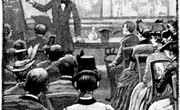Although in the English language there are a total of eight parts of speech, the most important ones can be reduced to five, which are nouns, verbs, pronouns, adjectives and adverbs. By recognizing and knowing these parts of speech, you will be able to follow and understand the most essential and relevant grammar topics.
Nouns
Nouns refer to either people, objects, events or ideas. Words that can be counted or accompanied by the article "the" generally fall into this category. There is also the difference between proper nouns, such as names, "Declaration of Independence" or "Oreo," and common nouns, such as "document" or "cookies." Proper nouns are usually one of a kind and are capitalized.
Verbs
Verbs refer to actions or states. For example, "run" is a verb and involves an action, whereas "be" is a state and does not involve movement. Verbs are usually conjugated, meaning that they agree with the subject or the "doer" of the sentences. For example, "I run," but "he runs." Verbs are used in different tenses, such as the present, past and future.
Pronouns
Pronouns refer to nouns, as the prefix "pro" stands for the word "for." They can exist in the first person, "I," or the second person, "you," or the third person singular, "he,” “she,” “it.” In addition, there are also the plural forms of "we," "you" (more than one person) and "they." Since personal pronouns work as subjects of the sentence, it is important to check subject-verb agreement. For instance, "it is," but "they are."
Adjectives
Adjectives give information about or describe the noun or pronoun. They are characteristics of the person, object or event, such as a "beautiful" woman or an "expensive" car. They may give details about height, weight, shape, color and one's value judgment or personal opinion on the quality of the noun, such as an "interesting" or "boring" movie.
Adverbs
Adverbs tell us "how" something is done and give us information about time, frequency and manner. They often, but not always, end with "ly." For example, he walks "slowly" or she drives "carefully." However, "friendly" may look like an adverb, but it is actually an adjective, such as a "friendly" neighbor. Adverbs do not only refer to verbs, but they can also describe adjectives or even other adverbs, as the different cases of the adverb "very" illustrate: He is a "very" interesting person or she walked "very" slowly.
Related Articles
References
Writer Bio
Based in Vancouver, Canada, Arash Farzaneh has been writing since 1990. His articles and stories have been published in "Bewildering Stories," "The Truth Magazine," "Inscribed" and "34th Parallel." Farzaneh received the French Government Book Prize in 2001. He holds a Master of Arts in French literature from the University of British Columbia.











